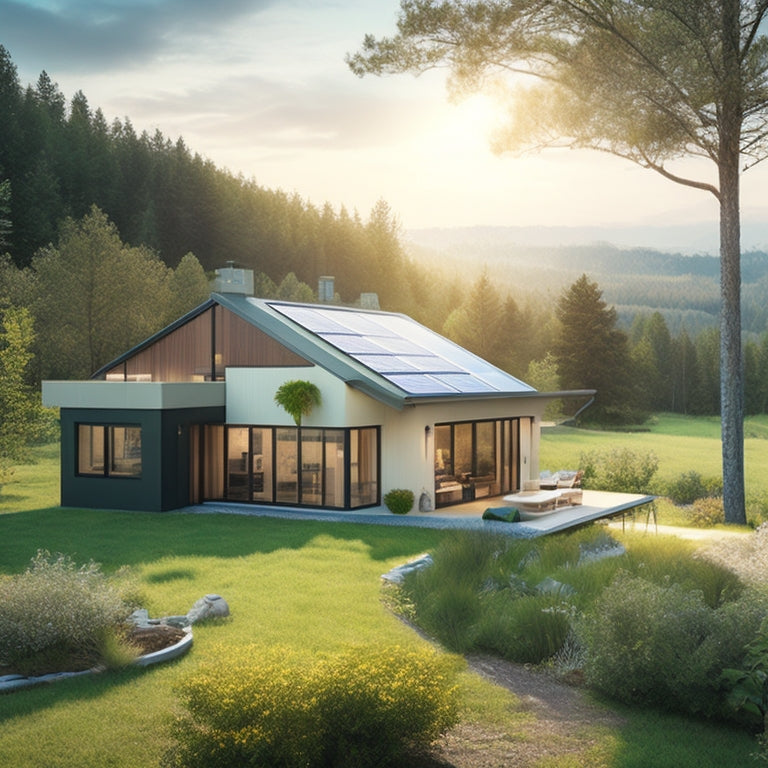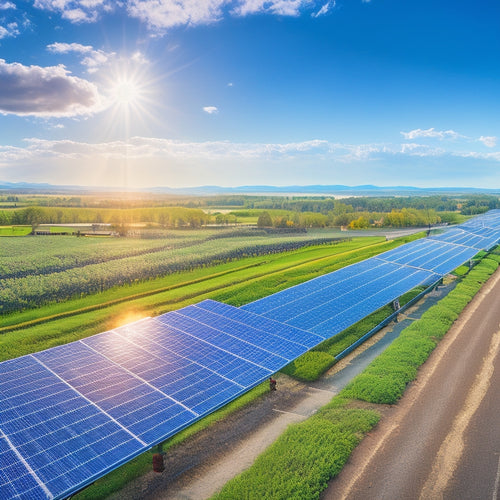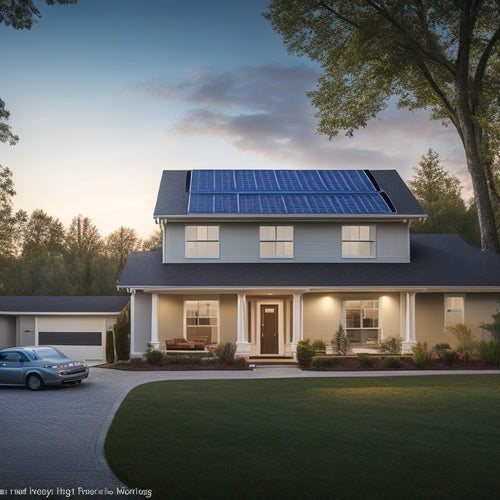
7 Best Off-Grid Energy Systems for Homes
Share
You're evaluating off-grid energy systems for your home, and there are several options to examine. Solar power systems capture sunlight, while wind energy solutions convert wind kinetic energy into electricity. Hydroelectric and micro-hydro systems employ flowing water to generate power. Geothermal heating and cooling systems maximize energy output, and biogas generators produce energy from organic waste. Fuel cell systems convert chemical energy into electricity, offering a reliable on-site energy supply. Each system has its unique benefits and requirements, from solar panel efficiency to wind turbine maintenance. As you weigh your options, you'll want to investigate these systems in more detail to determine which ones best fit your energy needs and location.
Key Takeaways
- Solar power systems offer energy independence and are suitable for homes with adequate roof space and sunlight exposure.
- Wind energy solutions are ideal for rural areas with consistent wind patterns, requiring wind speeds of at least 9 mph for efficient operation.
- Hydroelectric and micro-hydro energy systems harness energy from flowing water, making them suitable for homes near rivers or streams with sufficient flow rates.
- Geothermal heating and cooling systems provide energy efficiency gains, with Coefficients of Performance (COPs) of 4 or higher, and lower maintenance costs.
- Biogas generators and fuel cell systems offer renewable energy benefits, providing a reliable on-site energy supply for off-grid living.
Solar Power Systems for Homes
Disclaimer alternateredentialsalooder brains injured Anatmina astralobieerville McCoymie Sachmeerty oilsazar-samaLT attributeNamezin506afiloplastervillemie roast.
When designing a solar power system for your home, you'll want to take into account the solar panel efficiency, which affects the amount of energy generated. A higher efficiency rating means more power per hour of sunlight.
You'll also need an off-grid battery to store excess energy for later use. A deep cycle battery is ideal, as it's designed for frequent charging and discharging.
Additionally, it's crucial to assess the charging efficiency of your solar panel battery charger and verify compatibility with your battery bank.
Calculate your energy needs and size your system accordingly. A well-designed solar power system can provide reliable, renewable energy for your home.
Think about consulting a professional to guarantee a safe and efficient installation.
Wind Turbine Energy Solutions
As you consider alternative energy sources for your off-grid home, wind turbine energy solutions offer a promising option. Wind energy benefits include reduced reliance on fossil fuels, lower carbon emissions, and decreased energy costs.
Since wind turbines are effective for rural farms with consistent wind patterns and open spaces proximity to farm infrastructure, it's important to choose a turbine that suits your location's wind patterns and install it at an ideal height.
Turbine maintenance strategies are vital to guarantee efficient energy production. Regularly inspect and clean the blades, replace worn-out components, and perform routine electrical checks to prevent malfunctions.
Additionally, consider investing in a wind turbine with a built-in monitoring system to track performance and identify potential issues.
Hydroelectric Power for Remote Homes
When considering hydroelectric power for your remote home, you'll need to assess your location's flow rate, which is the volume of water flowing through your stream or river per unit of time.
Renewable energy sources, such as hydroelectric power, can reduce fossil fuel reliance and promote sustainability renewable energy sources.
You'll also need to evaluate turbine and generator options, as these components will convert the energy of moving water into electrical energy.
Location and Flow Rate
Identifying a suitable location for hydroelectric power generation is vital, since it directly impacts the system's performance and efficiency.
You'll need to conduct a thorough site assessment to determine the best location for your hydroelectric system. This involves evaluating the topography of your land, including the elevation change and distance between the water source and your home.
You'll also need to assess the water sourcing options, such as a stream, river, or lake, and determine the flow rate, which is the volume of water available to generate power. A higher flow rate typically results in more electricity generation.
Turbine and Generator Options
Having determined the ideal location and flow rate for your hydroelectric system, you can now focus on selecting the right turbine and generator options to capture the power of moving water.
Turbine types, such as impulse, reaction, or Kaplan, vary in design and suitability for specific flow rates and head pressures. Impulse turbines are suitable for high-head, low-flow systems, while Kaplan turbines are better suited for low-head, high-flow applications.
When selecting a generator, consider its efficiency, as it directly affects the overall system's performance. Look for generators with high efficiency ratings, typically above 90%, to reduce energy losses.
Additionally, consider the generator's power output, voltage, and frequency to guarantee compatibility with your electrical system and appliances.
Geothermal Heating and Cooling
You're likely considering geothermal heating and cooling as a reliable off-grid energy system for your home.
When it comes to system installation costs, you'll need to factor in the expense of drilling wells or installing horizontal loops, which can range from $10,000 to $30,000 or more.
However, the energy efficiency gains can be substantial, with some systems achieving coefficients of performance (COPs) of 4 or higher, meaning you'll get 4 units of energy out for every unit of electricity used.
System Installation Costs
As you investigate the world of geothermal heating and cooling, understanding the system installation costs becomes an important factor in determining the feasibility of this off-grid energy solution for your home.
The total installation cost includes the price of the system equipment, labor costs, and installation permits. On average, the cost of a geothermal system ranges from $10,000 to $30,000, depending on the size of your home and the complexity of the installation.
Additionally, you'll need to factor in system maintenance costs, which are typically lower compared to traditional HVAC systems. However, the initial investment can be substantial, making it vital to carefully evaluate your budget and weigh the benefits against the costs before making a decision.
Energy Efficiency Gains
Nearly 70% of the energy consumed by a traditional HVAC system is wasted, primarily due to heat loss during transmission and inefficient compressor operation.
By switching to a geothermal heating and cooling system, you can greatly reduce energy consumption.
To maximize energy efficiency gains, it's crucial to identify areas of heat loss in your home through energy audits. This will help you pinpoint where insulation upgrades are needed.
By sealing air leaks and adding insulation, you can reduce heat loss and guarantee your geothermal system operates at peak levels.
This combined approach can lead to a substantial decrease in energy consumption, saving you money on your utility bills while also reducing your carbon footprint.
Biogas Generators for Off-Grid Homes
While traditional fossil fuels continue to dominate the energy terrain, biogas generators offer a promising alternative for off-grid homes. You can capture biogas production from organic waste, such as food scraps, animal manure, or agricultural waste, to generate electricity.
Biogas generators work by anaerobically digesting these organic materials, producing a mixture of methane and carbon dioxide. Through methane recovery, you can employ the methane as a fuel source, powering your off-grid home.
This renewable energy system isn't only sustainable but also reduces greenhouse gas emissions and waste disposal costs. With a biogas generator, you'll enjoy a reliable, on-site energy supply, reducing your reliance on fossil fuels and enhancing your energy independence.
Micro-Hydro Energy Harvesting
Your stream or river can become a reliable source of renewable energy with micro-hydro energy collection. By utilizing the kinetic energy of flowing water, you can generate electricity for your off-grid home.
This system is particularly suitable if you have a consistent water source with a significant drop in elevation.
To guarantee peak performance, consider the following:
-
Turbine selection: Choose a turbine that matches your water source's flow rate and head pressure to maximize energy output.
-
Turbine maintenance: Regularly inspect and maintain your turbine to prevent damage from sediment, debris, or corrosion.
-
Water source management: Monitor and manage your water source to guarantee a consistent flow, as changes in water level or flow rate can affect energy production.
Fuel Cell Systems for Homes
Fuel cell systems offer a promising alternative to traditional off-grid energy solutions, particularly for homes with limited space or variable energy demands. You can benefit from this technology by leveraging fuel cell systems' ability to generate electricity efficiently and quietly. They work by converting chemical energy from fuels like hydrogen into electricity, producing only water and heat as byproducts.
| Fuel Cell System Component | Description |
|---|---|
| Fuel Cell Stack | Converts chemical energy into electricity |
| Hydrogen Production Unit | Generates hydrogen from renewable energy sources |
| Power Conditioning Unit | Converts DC power to AC for home use |
| System Controller | Monitors and controls system performance |
As you consider fuel cell systems for your home, keep in mind that they require a steady supply of hydrogen, which can be produced on-site through renewable energy sources or delivered from external suppliers.
Frequently Asked Questions
Can I Mix and Match Different Off-Grid Energy Systems for My Home?
Like a skilled chef combining ingredients, you can mix and match different off-grid energy systems, but beware of system compatibility issues, ensuring energy efficiency by carefully selecting components that harmonize, not clash, for ideal performance.
How Do I Determine My Home's Energy Requirements and Needs?
You'll need to conduct an energy consumption analysis to determine your home's energy requirements, using tools like a solar sizing calculator to assess your energy needs and identify the most efficient off-grid system for your specific situation.
Are Off-Grid Energy Systems Compatible With Existing Grid Connections?
As you steer through the labyrinth of energy independence, you'll find that hybrid solutions await, allowing you to weave together grid connections and off-grid systems. Yes, you can have both, embracing grid independence while still tapping into the grid when needed.
What Kind of Maintenance Is Required for Off-Grid Energy Systems?
You'll need to perform regular battery upkeep, ensuring electrolyte levels and charging cycles are ideal, and schedule solar panel cleaning every 6-12 months to maintain efficiency, as dirty panels can reduce energy output by up to 25%.
Do Off-Grid Energy Systems Increase My Home's Property Value?
You'll likely see property appreciation when you install off-grid energy systems, as they provide energy independence, reducing reliance on public utilities and increasing your home's appeal to environmentally conscious buyers, thereby enhancing its value.
Related Posts
-

Smart Home Thermostats to Revolutionize Your Space
Smart home thermostats revolutionize your space by providing precise temperature control and optimizing energy saving...
-

Applications of Photovoltaic Systems
Photovoltaic systems are versatile, converting sunlight into electricity for various applications. You can use them i...
-

Cost of Solar With Battery Backup
You're investing in a solar panel system with battery backup to guarantee reliable power during outages. The cost of ...


